A Review of Social Determinants & Health Concerns of Indigenous People
VerifiedAdded on 2021/06/16
|19
|4653
|30
Literature Review
AI Summary
This literature review examines the social determinants of health impacting Indigenous Australians, highlighting persistent health disparities between Indigenous and non-Indigenous populations. It analyzes media articles focusing on key issues such as child protection rates, racism in kidney transplants, and the concealment of racial identity by Indigenous doctors to avoid discrimination. The review connects these issues to relevant models and approaches, contributing to the ongoing debate about health inequities and systemic discrimination faced by Indigenous communities. It reflects on the need for improved health services, cultural sensitivity, and addressing the root causes of inequality to enhance the well-being of Aboriginal and Torres Strait Islander people.
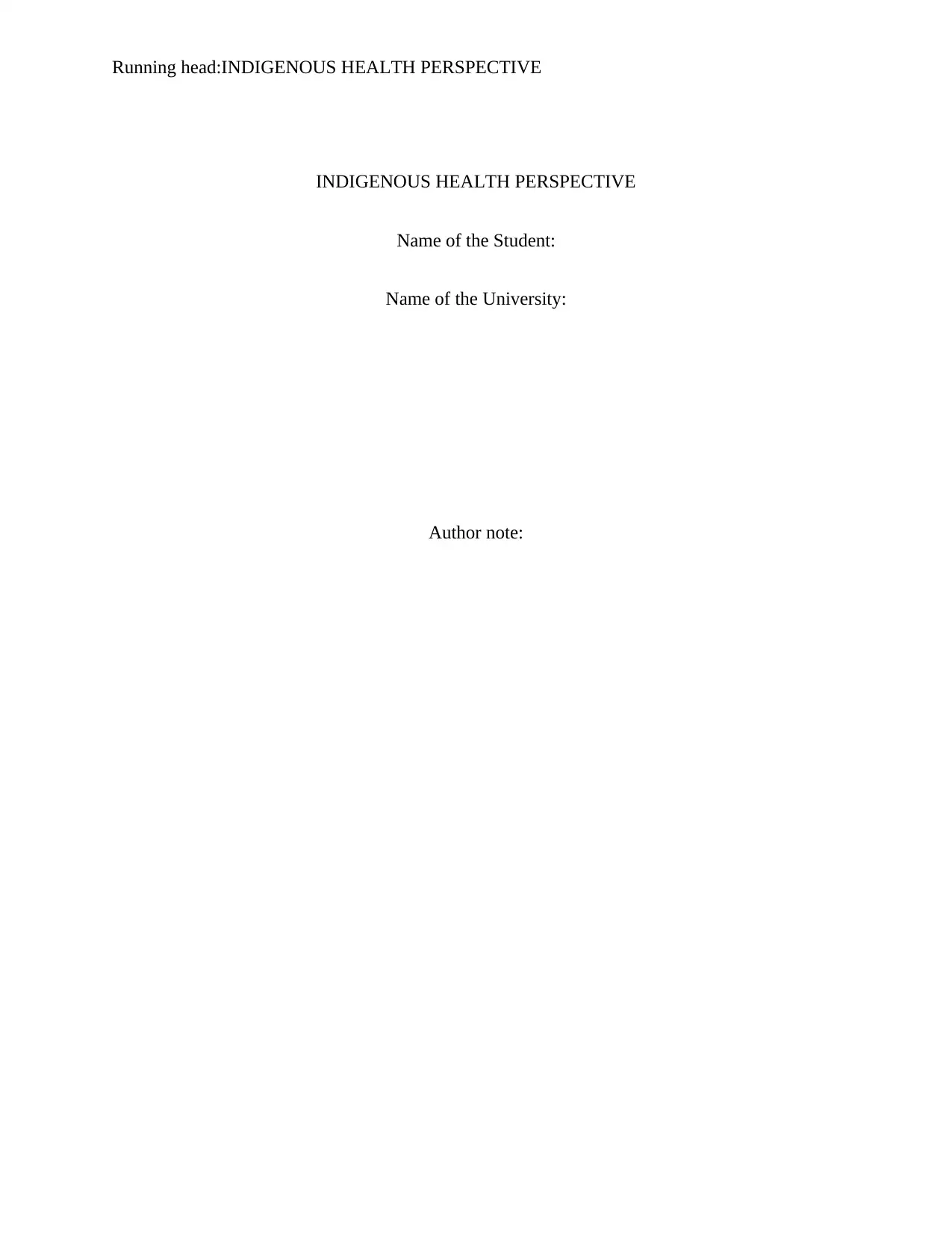
Running head:INDIGENOUS HEALTH PERSPECTIVE
INDIGENOUS HEALTH PERSPECTIVE
Name of the Student:
Name of the University:
Author note:
INDIGENOUS HEALTH PERSPECTIVE
Name of the Student:
Name of the University:
Author note:
Paraphrase This Document
Need a fresh take? Get an instant paraphrase of this document with our AI Paraphraser
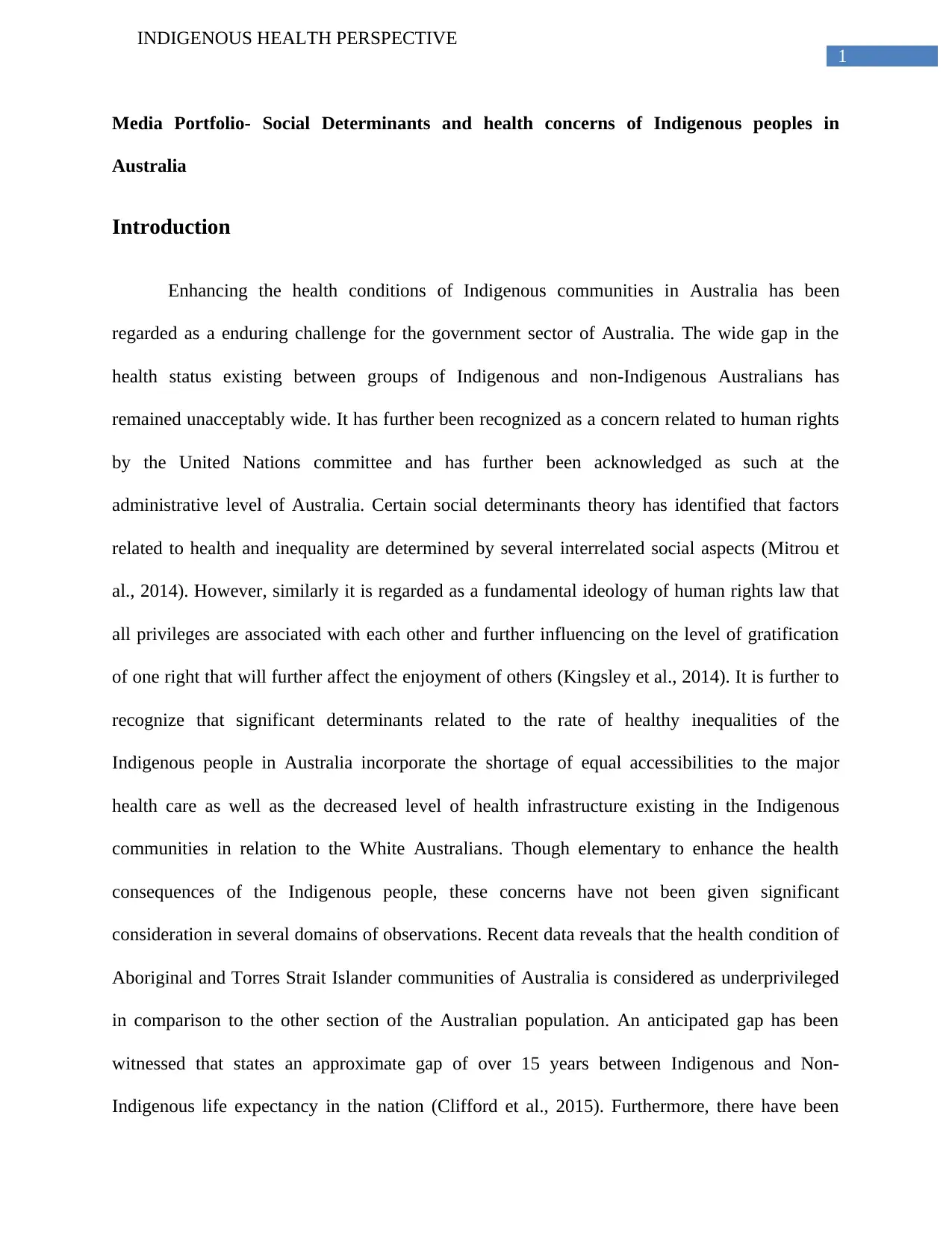
1
INDIGENOUS HEALTH PERSPECTIVE
Media Portfolio- Social Determinants and health concerns of Indigenous peoples in
Australia
Introduction
Enhancing the health conditions of Indigenous communities in Australia has been
regarded as a enduring challenge for the government sector of Australia. The wide gap in the
health status existing between groups of Indigenous and non-Indigenous Australians has
remained unacceptably wide. It has further been recognized as a concern related to human rights
by the United Nations committee and has further been acknowledged as such at the
administrative level of Australia. Certain social determinants theory has identified that factors
related to health and inequality are determined by several interrelated social aspects (Mitrou et
al., 2014). However, similarly it is regarded as a fundamental ideology of human rights law that
all privileges are associated with each other and further influencing on the level of gratification
of one right that will further affect the enjoyment of others (Kingsley et al., 2014). It is further to
recognize that significant determinants related to the rate of healthy inequalities of the
Indigenous people in Australia incorporate the shortage of equal accessibilities to the major
health care as well as the decreased level of health infrastructure existing in the Indigenous
communities in relation to the White Australians. Though elementary to enhance the health
consequences of the Indigenous people, these concerns have not been given significant
consideration in several domains of observations. Recent data reveals that the health condition of
Aboriginal and Torres Strait Islander communities of Australia is considered as underprivileged
in comparison to the other section of the Australian population. An anticipated gap has been
witnessed that states an approximate gap of over 15 years between Indigenous and Non-
Indigenous life expectancy in the nation (Clifford et al., 2015). Furthermore, there have been
INDIGENOUS HEALTH PERSPECTIVE
Media Portfolio- Social Determinants and health concerns of Indigenous peoples in
Australia
Introduction
Enhancing the health conditions of Indigenous communities in Australia has been
regarded as a enduring challenge for the government sector of Australia. The wide gap in the
health status existing between groups of Indigenous and non-Indigenous Australians has
remained unacceptably wide. It has further been recognized as a concern related to human rights
by the United Nations committee and has further been acknowledged as such at the
administrative level of Australia. Certain social determinants theory has identified that factors
related to health and inequality are determined by several interrelated social aspects (Mitrou et
al., 2014). However, similarly it is regarded as a fundamental ideology of human rights law that
all privileges are associated with each other and further influencing on the level of gratification
of one right that will further affect the enjoyment of others (Kingsley et al., 2014). It is further to
recognize that significant determinants related to the rate of healthy inequalities of the
Indigenous people in Australia incorporate the shortage of equal accessibilities to the major
health care as well as the decreased level of health infrastructure existing in the Indigenous
communities in relation to the White Australians. Though elementary to enhance the health
consequences of the Indigenous people, these concerns have not been given significant
consideration in several domains of observations. Recent data reveals that the health condition of
Aboriginal and Torres Strait Islander communities of Australia is considered as underprivileged
in comparison to the other section of the Australian population. An anticipated gap has been
witnessed that states an approximate gap of over 15 years between Indigenous and Non-
Indigenous life expectancy in the nation (Clifford et al., 2015). Furthermore, there have been
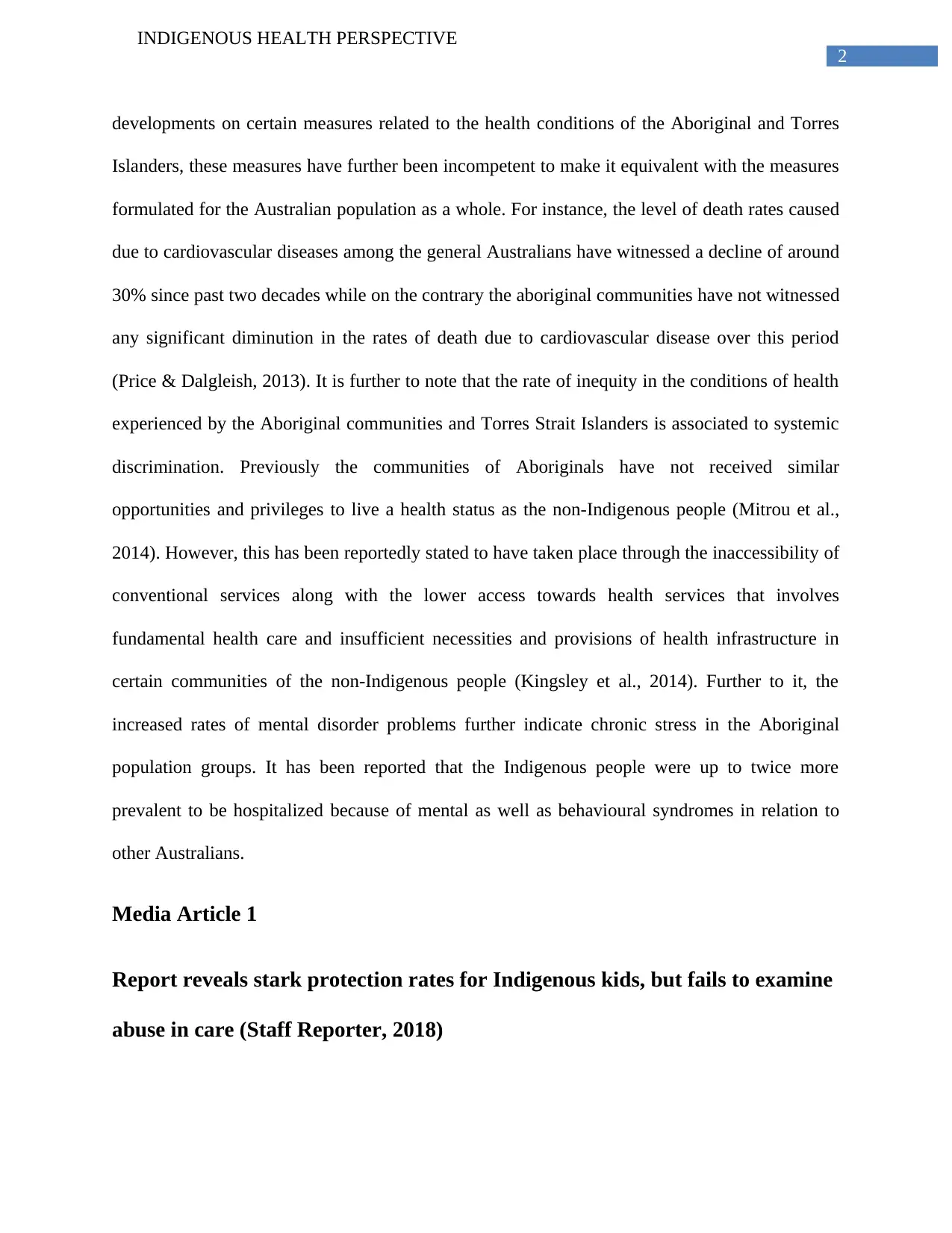
2
INDIGENOUS HEALTH PERSPECTIVE
developments on certain measures related to the health conditions of the Aboriginal and Torres
Islanders, these measures have further been incompetent to make it equivalent with the measures
formulated for the Australian population as a whole. For instance, the level of death rates caused
due to cardiovascular diseases among the general Australians have witnessed a decline of around
30% since past two decades while on the contrary the aboriginal communities have not witnessed
any significant diminution in the rates of death due to cardiovascular disease over this period
(Price & Dalgleish, 2013). It is further to note that the rate of inequity in the conditions of health
experienced by the Aboriginal communities and Torres Strait Islanders is associated to systemic
discrimination. Previously the communities of Aboriginals have not received similar
opportunities and privileges to live a health status as the non-Indigenous people (Mitrou et al.,
2014). However, this has been reportedly stated to have taken place through the inaccessibility of
conventional services along with the lower access towards health services that involves
fundamental health care and insufficient necessities and provisions of health infrastructure in
certain communities of the non-Indigenous people (Kingsley et al., 2014). Further to it, the
increased rates of mental disorder problems further indicate chronic stress in the Aboriginal
population groups. It has been reported that the Indigenous people were up to twice more
prevalent to be hospitalized because of mental as well as behavioural syndromes in relation to
other Australians.
Media Article 1
Report reveals stark protection rates for Indigenous kids, but fails to examine
abuse in care (Staff Reporter, 2018)
INDIGENOUS HEALTH PERSPECTIVE
developments on certain measures related to the health conditions of the Aboriginal and Torres
Islanders, these measures have further been incompetent to make it equivalent with the measures
formulated for the Australian population as a whole. For instance, the level of death rates caused
due to cardiovascular diseases among the general Australians have witnessed a decline of around
30% since past two decades while on the contrary the aboriginal communities have not witnessed
any significant diminution in the rates of death due to cardiovascular disease over this period
(Price & Dalgleish, 2013). It is further to note that the rate of inequity in the conditions of health
experienced by the Aboriginal communities and Torres Strait Islanders is associated to systemic
discrimination. Previously the communities of Aboriginals have not received similar
opportunities and privileges to live a health status as the non-Indigenous people (Mitrou et al.,
2014). However, this has been reportedly stated to have taken place through the inaccessibility of
conventional services along with the lower access towards health services that involves
fundamental health care and insufficient necessities and provisions of health infrastructure in
certain communities of the non-Indigenous people (Kingsley et al., 2014). Further to it, the
increased rates of mental disorder problems further indicate chronic stress in the Aboriginal
population groups. It has been reported that the Indigenous people were up to twice more
prevalent to be hospitalized because of mental as well as behavioural syndromes in relation to
other Australians.
Media Article 1
Report reveals stark protection rates for Indigenous kids, but fails to examine
abuse in care (Staff Reporter, 2018)
⊘ This is a preview!⊘
Do you want full access?
Subscribe today to unlock all pages.

Trusted by 1+ million students worldwide
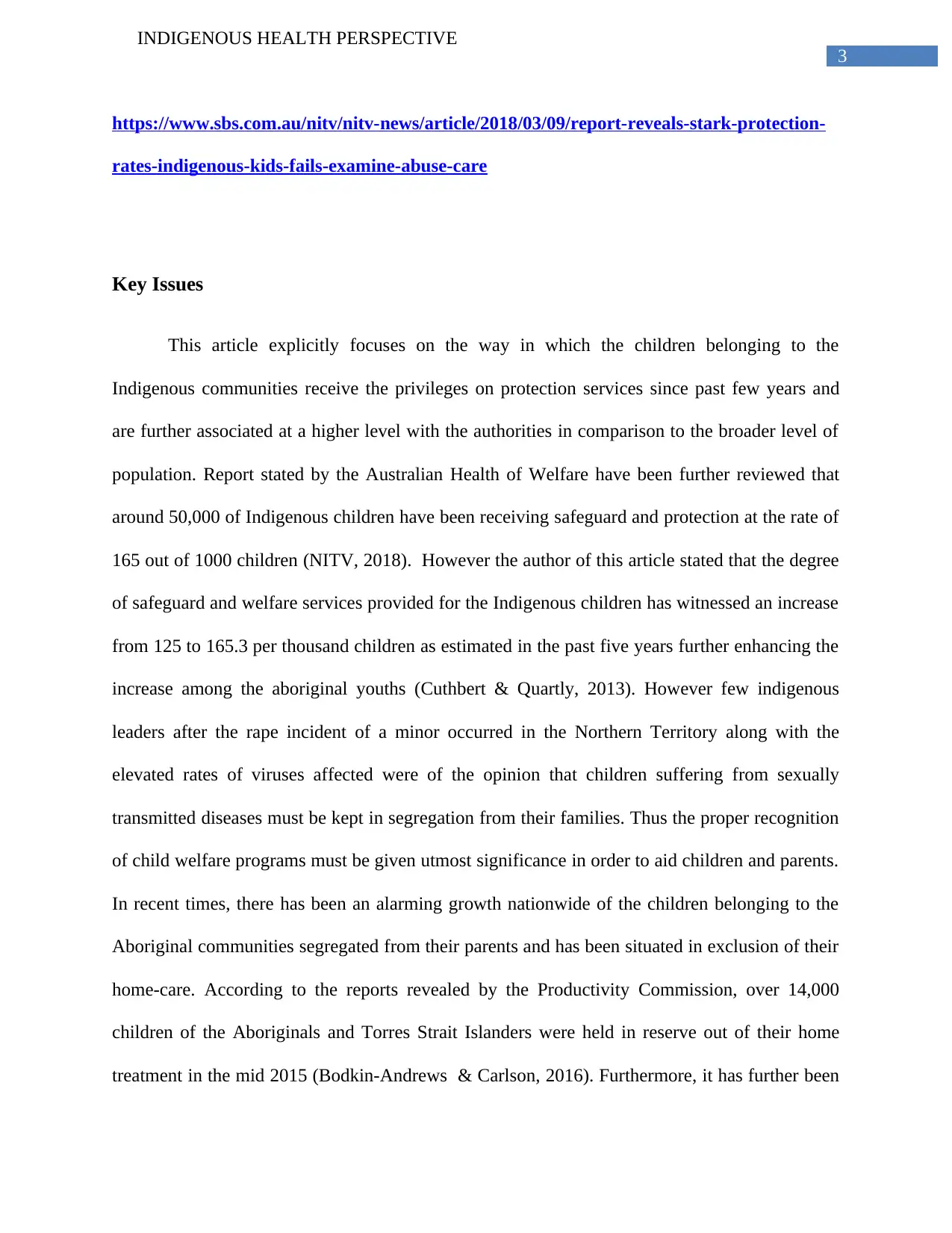
3
INDIGENOUS HEALTH PERSPECTIVE
https://www.sbs.com.au/nitv/nitv-news/article/2018/03/09/report-reveals-stark-protection-
rates-indigenous-kids-fails-examine-abuse-care
Key Issues
This article explicitly focuses on the way in which the children belonging to the
Indigenous communities receive the privileges on protection services since past few years and
are further associated at a higher level with the authorities in comparison to the broader level of
population. Report stated by the Australian Health of Welfare have been further reviewed that
around 50,000 of Indigenous children have been receiving safeguard and protection at the rate of
165 out of 1000 children (NITV, 2018). However the author of this article stated that the degree
of safeguard and welfare services provided for the Indigenous children has witnessed an increase
from 125 to 165.3 per thousand children as estimated in the past five years further enhancing the
increase among the aboriginal youths (Cuthbert & Quartly, 2013). However few indigenous
leaders after the rape incident of a minor occurred in the Northern Territory along with the
elevated rates of viruses affected were of the opinion that children suffering from sexually
transmitted diseases must be kept in segregation from their families. Thus the proper recognition
of child welfare programs must be given utmost significance in order to aid children and parents.
In recent times, there has been an alarming growth nationwide of the children belonging to the
Aboriginal communities segregated from their parents and has been situated in exclusion of their
home-care. According to the reports revealed by the Productivity Commission, over 14,000
children of the Aboriginals and Torres Strait Islanders were held in reserve out of their home
treatment in the mid 2015 (Bodkin-Andrews & Carlson, 2016). Furthermore, it has further been
INDIGENOUS HEALTH PERSPECTIVE
https://www.sbs.com.au/nitv/nitv-news/article/2018/03/09/report-reveals-stark-protection-
rates-indigenous-kids-fails-examine-abuse-care
Key Issues
This article explicitly focuses on the way in which the children belonging to the
Indigenous communities receive the privileges on protection services since past few years and
are further associated at a higher level with the authorities in comparison to the broader level of
population. Report stated by the Australian Health of Welfare have been further reviewed that
around 50,000 of Indigenous children have been receiving safeguard and protection at the rate of
165 out of 1000 children (NITV, 2018). However the author of this article stated that the degree
of safeguard and welfare services provided for the Indigenous children has witnessed an increase
from 125 to 165.3 per thousand children as estimated in the past five years further enhancing the
increase among the aboriginal youths (Cuthbert & Quartly, 2013). However few indigenous
leaders after the rape incident of a minor occurred in the Northern Territory along with the
elevated rates of viruses affected were of the opinion that children suffering from sexually
transmitted diseases must be kept in segregation from their families. Thus the proper recognition
of child welfare programs must be given utmost significance in order to aid children and parents.
In recent times, there has been an alarming growth nationwide of the children belonging to the
Aboriginal communities segregated from their parents and has been situated in exclusion of their
home-care. According to the reports revealed by the Productivity Commission, over 14,000
children of the Aboriginals and Torres Strait Islanders were held in reserve out of their home
treatment in the mid 2015 (Bodkin-Andrews & Carlson, 2016). Furthermore, it has further been
Paraphrase This Document
Need a fresh take? Get an instant paraphrase of this document with our AI Paraphraser
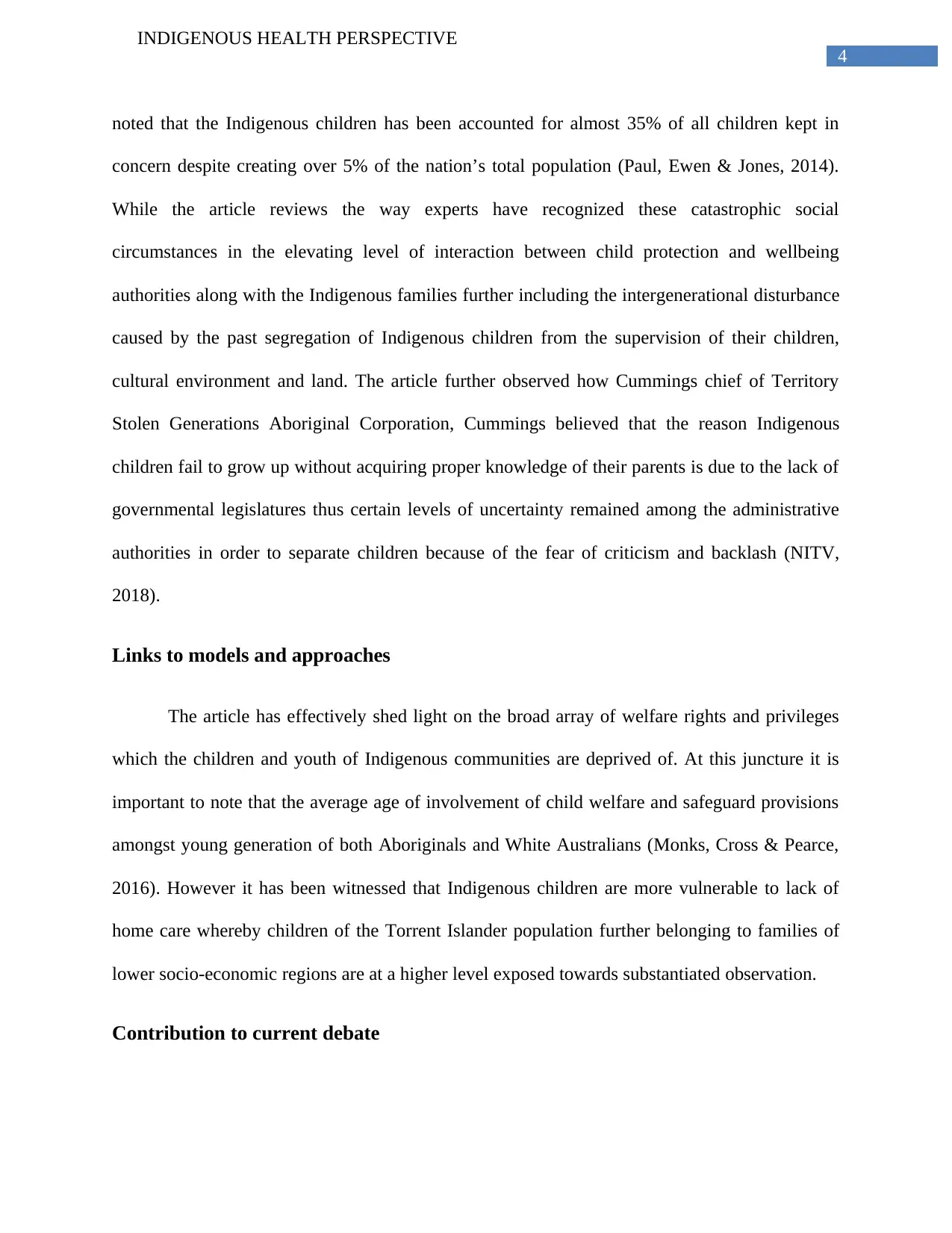
4
INDIGENOUS HEALTH PERSPECTIVE
noted that the Indigenous children has been accounted for almost 35% of all children kept in
concern despite creating over 5% of the nation’s total population (Paul, Ewen & Jones, 2014).
While the article reviews the way experts have recognized these catastrophic social
circumstances in the elevating level of interaction between child protection and wellbeing
authorities along with the Indigenous families further including the intergenerational disturbance
caused by the past segregation of Indigenous children from the supervision of their children,
cultural environment and land. The article further observed how Cummings chief of Territory
Stolen Generations Aboriginal Corporation, Cummings believed that the reason Indigenous
children fail to grow up without acquiring proper knowledge of their parents is due to the lack of
governmental legislatures thus certain levels of uncertainty remained among the administrative
authorities in order to separate children because of the fear of criticism and backlash (NITV,
2018).
Links to models and approaches
The article has effectively shed light on the broad array of welfare rights and privileges
which the children and youth of Indigenous communities are deprived of. At this juncture it is
important to note that the average age of involvement of child welfare and safeguard provisions
amongst young generation of both Aboriginals and White Australians (Monks, Cross & Pearce,
2016). However it has been witnessed that Indigenous children are more vulnerable to lack of
home care whereby children of the Torrent Islander population further belonging to families of
lower socio-economic regions are at a higher level exposed towards substantiated observation.
Contribution to current debate
INDIGENOUS HEALTH PERSPECTIVE
noted that the Indigenous children has been accounted for almost 35% of all children kept in
concern despite creating over 5% of the nation’s total population (Paul, Ewen & Jones, 2014).
While the article reviews the way experts have recognized these catastrophic social
circumstances in the elevating level of interaction between child protection and wellbeing
authorities along with the Indigenous families further including the intergenerational disturbance
caused by the past segregation of Indigenous children from the supervision of their children,
cultural environment and land. The article further observed how Cummings chief of Territory
Stolen Generations Aboriginal Corporation, Cummings believed that the reason Indigenous
children fail to grow up without acquiring proper knowledge of their parents is due to the lack of
governmental legislatures thus certain levels of uncertainty remained among the administrative
authorities in order to separate children because of the fear of criticism and backlash (NITV,
2018).
Links to models and approaches
The article has effectively shed light on the broad array of welfare rights and privileges
which the children and youth of Indigenous communities are deprived of. At this juncture it is
important to note that the average age of involvement of child welfare and safeguard provisions
amongst young generation of both Aboriginals and White Australians (Monks, Cross & Pearce,
2016). However it has been witnessed that Indigenous children are more vulnerable to lack of
home care whereby children of the Torrent Islander population further belonging to families of
lower socio-economic regions are at a higher level exposed towards substantiated observation.
Contribution to current debate
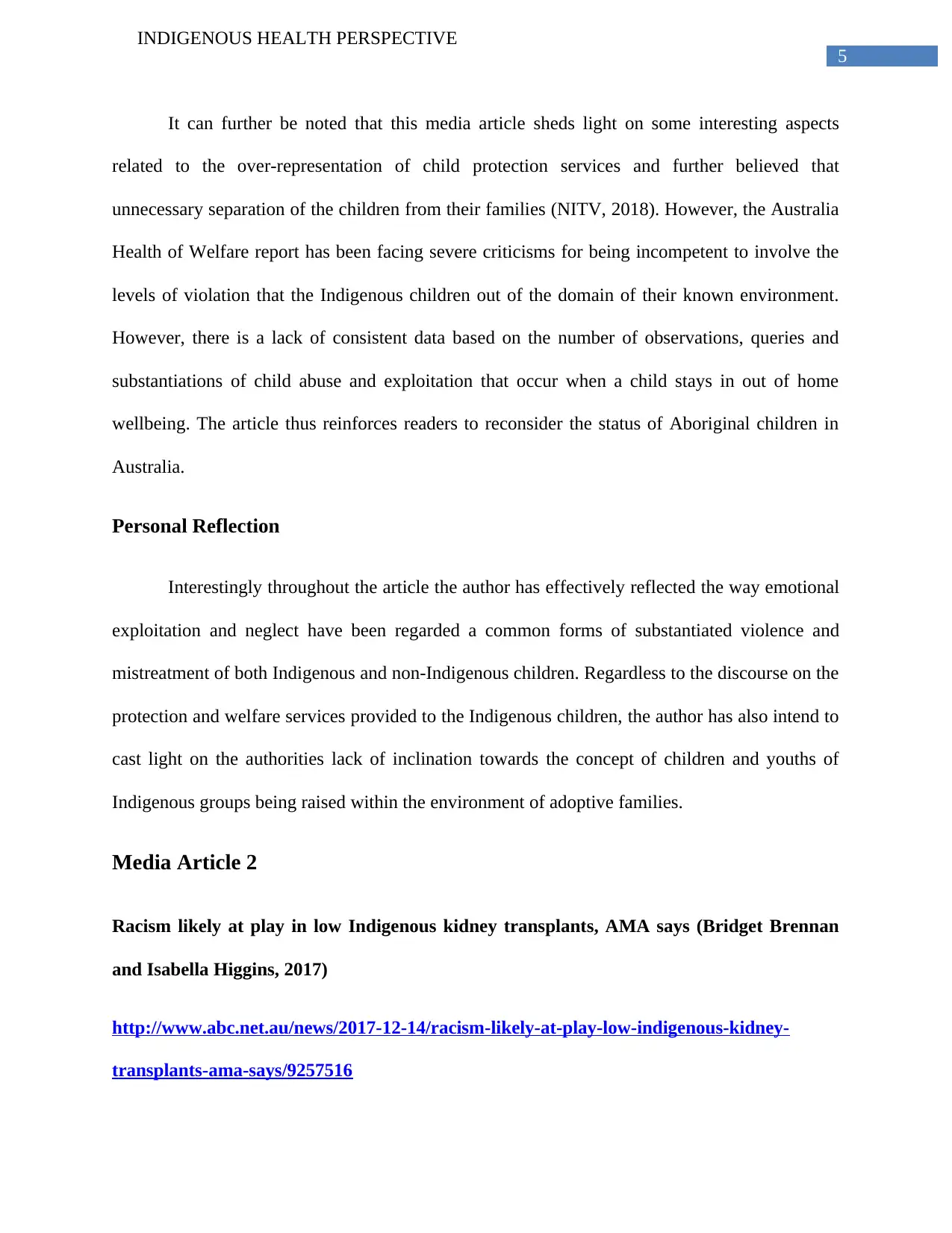
5
INDIGENOUS HEALTH PERSPECTIVE
It can further be noted that this media article sheds light on some interesting aspects
related to the over-representation of child protection services and further believed that
unnecessary separation of the children from their families (NITV, 2018). However, the Australia
Health of Welfare report has been facing severe criticisms for being incompetent to involve the
levels of violation that the Indigenous children out of the domain of their known environment.
However, there is a lack of consistent data based on the number of observations, queries and
substantiations of child abuse and exploitation that occur when a child stays in out of home
wellbeing. The article thus reinforces readers to reconsider the status of Aboriginal children in
Australia.
Personal Reflection
Interestingly throughout the article the author has effectively reflected the way emotional
exploitation and neglect have been regarded a common forms of substantiated violence and
mistreatment of both Indigenous and non-Indigenous children. Regardless to the discourse on the
protection and welfare services provided to the Indigenous children, the author has also intend to
cast light on the authorities lack of inclination towards the concept of children and youths of
Indigenous groups being raised within the environment of adoptive families.
Media Article 2
Racism likely at play in low Indigenous kidney transplants, AMA says (Bridget Brennan
and Isabella Higgins, 2017)
http://www.abc.net.au/news/2017-12-14/racism-likely-at-play-low-indigenous-kidney-
transplants-ama-says/9257516
INDIGENOUS HEALTH PERSPECTIVE
It can further be noted that this media article sheds light on some interesting aspects
related to the over-representation of child protection services and further believed that
unnecessary separation of the children from their families (NITV, 2018). However, the Australia
Health of Welfare report has been facing severe criticisms for being incompetent to involve the
levels of violation that the Indigenous children out of the domain of their known environment.
However, there is a lack of consistent data based on the number of observations, queries and
substantiations of child abuse and exploitation that occur when a child stays in out of home
wellbeing. The article thus reinforces readers to reconsider the status of Aboriginal children in
Australia.
Personal Reflection
Interestingly throughout the article the author has effectively reflected the way emotional
exploitation and neglect have been regarded a common forms of substantiated violence and
mistreatment of both Indigenous and non-Indigenous children. Regardless to the discourse on the
protection and welfare services provided to the Indigenous children, the author has also intend to
cast light on the authorities lack of inclination towards the concept of children and youths of
Indigenous groups being raised within the environment of adoptive families.
Media Article 2
Racism likely at play in low Indigenous kidney transplants, AMA says (Bridget Brennan
and Isabella Higgins, 2017)
http://www.abc.net.au/news/2017-12-14/racism-likely-at-play-low-indigenous-kidney-
transplants-ama-says/9257516
⊘ This is a preview!⊘
Do you want full access?
Subscribe today to unlock all pages.

Trusted by 1+ million students worldwide
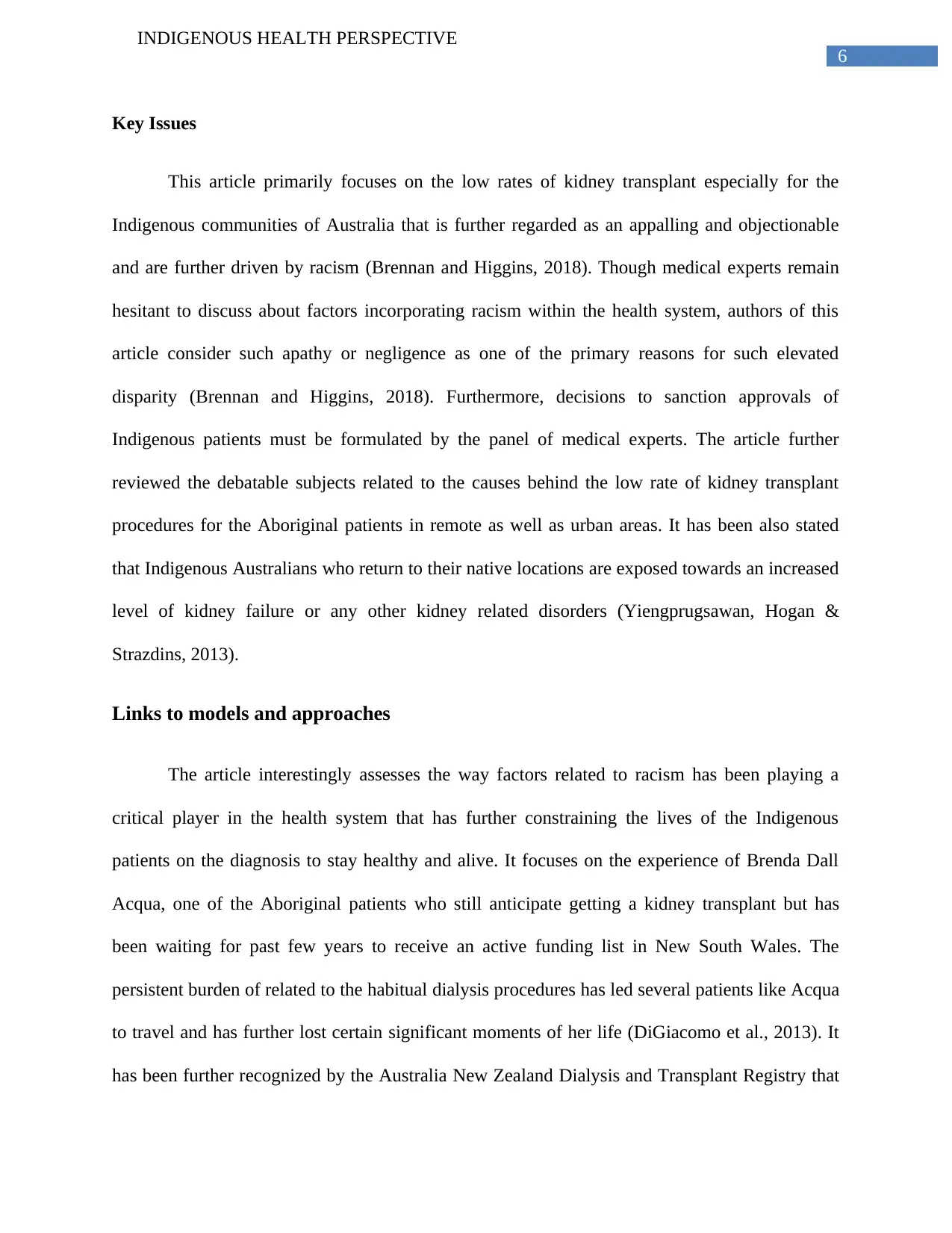
6
INDIGENOUS HEALTH PERSPECTIVE
Key Issues
This article primarily focuses on the low rates of kidney transplant especially for the
Indigenous communities of Australia that is further regarded as an appalling and objectionable
and are further driven by racism (Brennan and Higgins, 2018). Though medical experts remain
hesitant to discuss about factors incorporating racism within the health system, authors of this
article consider such apathy or negligence as one of the primary reasons for such elevated
disparity (Brennan and Higgins, 2018). Furthermore, decisions to sanction approvals of
Indigenous patients must be formulated by the panel of medical experts. The article further
reviewed the debatable subjects related to the causes behind the low rate of kidney transplant
procedures for the Aboriginal patients in remote as well as urban areas. It has been also stated
that Indigenous Australians who return to their native locations are exposed towards an increased
level of kidney failure or any other kidney related disorders (Yiengprugsawan, Hogan &
Strazdins, 2013).
Links to models and approaches
The article interestingly assesses the way factors related to racism has been playing a
critical player in the health system that has further constraining the lives of the Indigenous
patients on the diagnosis to stay healthy and alive. It focuses on the experience of Brenda Dall
Acqua, one of the Aboriginal patients who still anticipate getting a kidney transplant but has
been waiting for past few years to receive an active funding list in New South Wales. The
persistent burden of related to the habitual dialysis procedures has led several patients like Acqua
to travel and has further lost certain significant moments of her life (DiGiacomo et al., 2013). It
has been further recognized by the Australia New Zealand Dialysis and Transplant Registry that
INDIGENOUS HEALTH PERSPECTIVE
Key Issues
This article primarily focuses on the low rates of kidney transplant especially for the
Indigenous communities of Australia that is further regarded as an appalling and objectionable
and are further driven by racism (Brennan and Higgins, 2018). Though medical experts remain
hesitant to discuss about factors incorporating racism within the health system, authors of this
article consider such apathy or negligence as one of the primary reasons for such elevated
disparity (Brennan and Higgins, 2018). Furthermore, decisions to sanction approvals of
Indigenous patients must be formulated by the panel of medical experts. The article further
reviewed the debatable subjects related to the causes behind the low rate of kidney transplant
procedures for the Aboriginal patients in remote as well as urban areas. It has been also stated
that Indigenous Australians who return to their native locations are exposed towards an increased
level of kidney failure or any other kidney related disorders (Yiengprugsawan, Hogan &
Strazdins, 2013).
Links to models and approaches
The article interestingly assesses the way factors related to racism has been playing a
critical player in the health system that has further constraining the lives of the Indigenous
patients on the diagnosis to stay healthy and alive. It focuses on the experience of Brenda Dall
Acqua, one of the Aboriginal patients who still anticipate getting a kidney transplant but has
been waiting for past few years to receive an active funding list in New South Wales. The
persistent burden of related to the habitual dialysis procedures has led several patients like Acqua
to travel and has further lost certain significant moments of her life (DiGiacomo et al., 2013). It
has been further recognized by the Australia New Zealand Dialysis and Transplant Registry that
Paraphrase This Document
Need a fresh take? Get an instant paraphrase of this document with our AI Paraphraser
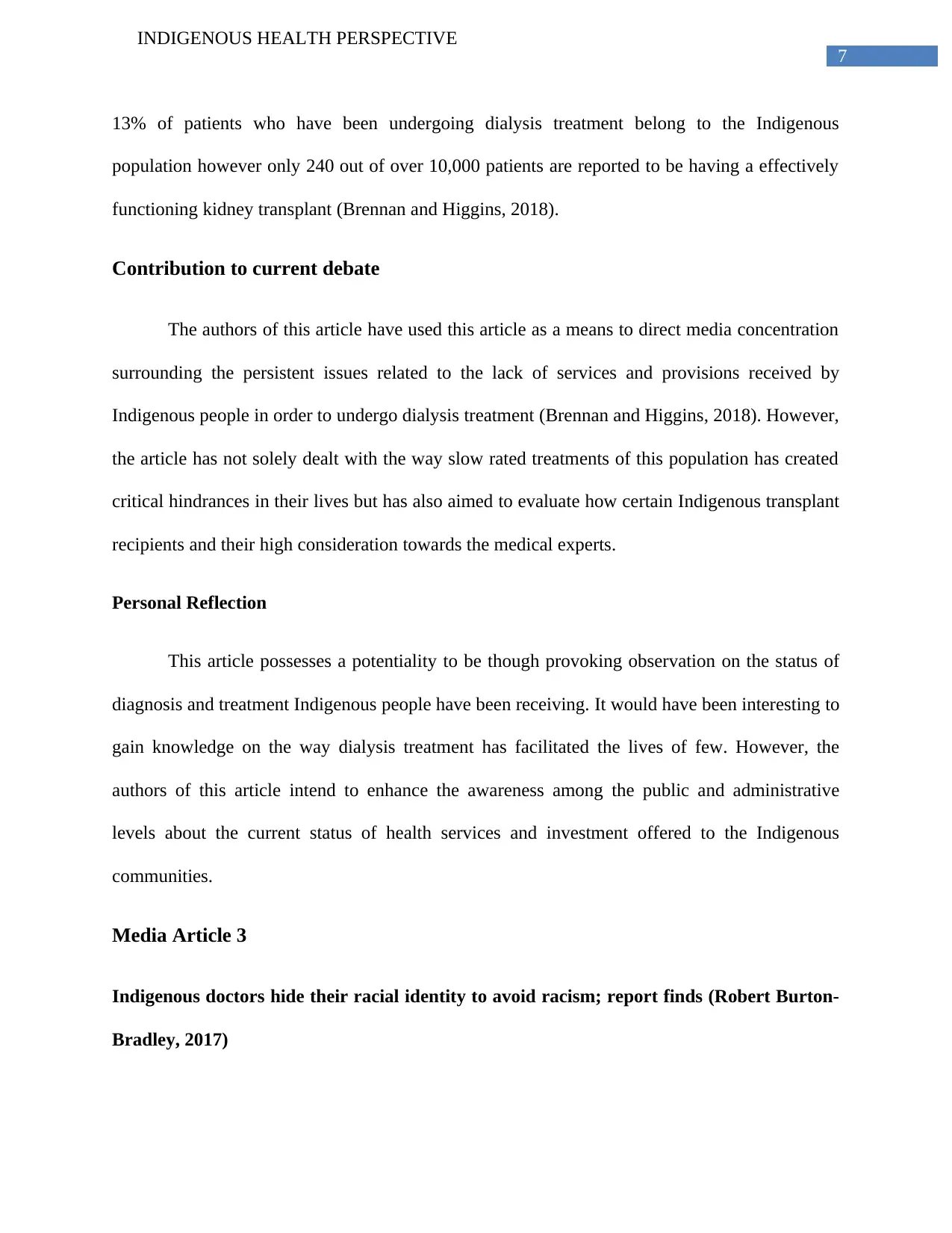
7
INDIGENOUS HEALTH PERSPECTIVE
13% of patients who have been undergoing dialysis treatment belong to the Indigenous
population however only 240 out of over 10,000 patients are reported to be having a effectively
functioning kidney transplant (Brennan and Higgins, 2018).
Contribution to current debate
The authors of this article have used this article as a means to direct media concentration
surrounding the persistent issues related to the lack of services and provisions received by
Indigenous people in order to undergo dialysis treatment (Brennan and Higgins, 2018). However,
the article has not solely dealt with the way slow rated treatments of this population has created
critical hindrances in their lives but has also aimed to evaluate how certain Indigenous transplant
recipients and their high consideration towards the medical experts.
Personal Reflection
This article possesses a potentiality to be though provoking observation on the status of
diagnosis and treatment Indigenous people have been receiving. It would have been interesting to
gain knowledge on the way dialysis treatment has facilitated the lives of few. However, the
authors of this article intend to enhance the awareness among the public and administrative
levels about the current status of health services and investment offered to the Indigenous
communities.
Media Article 3
Indigenous doctors hide their racial identity to avoid racism; report finds (Robert Burton-
Bradley, 2017)
INDIGENOUS HEALTH PERSPECTIVE
13% of patients who have been undergoing dialysis treatment belong to the Indigenous
population however only 240 out of over 10,000 patients are reported to be having a effectively
functioning kidney transplant (Brennan and Higgins, 2018).
Contribution to current debate
The authors of this article have used this article as a means to direct media concentration
surrounding the persistent issues related to the lack of services and provisions received by
Indigenous people in order to undergo dialysis treatment (Brennan and Higgins, 2018). However,
the article has not solely dealt with the way slow rated treatments of this population has created
critical hindrances in their lives but has also aimed to evaluate how certain Indigenous transplant
recipients and their high consideration towards the medical experts.
Personal Reflection
This article possesses a potentiality to be though provoking observation on the status of
diagnosis and treatment Indigenous people have been receiving. It would have been interesting to
gain knowledge on the way dialysis treatment has facilitated the lives of few. However, the
authors of this article intend to enhance the awareness among the public and administrative
levels about the current status of health services and investment offered to the Indigenous
communities.
Media Article 3
Indigenous doctors hide their racial identity to avoid racism; report finds (Robert Burton-
Bradley, 2017)
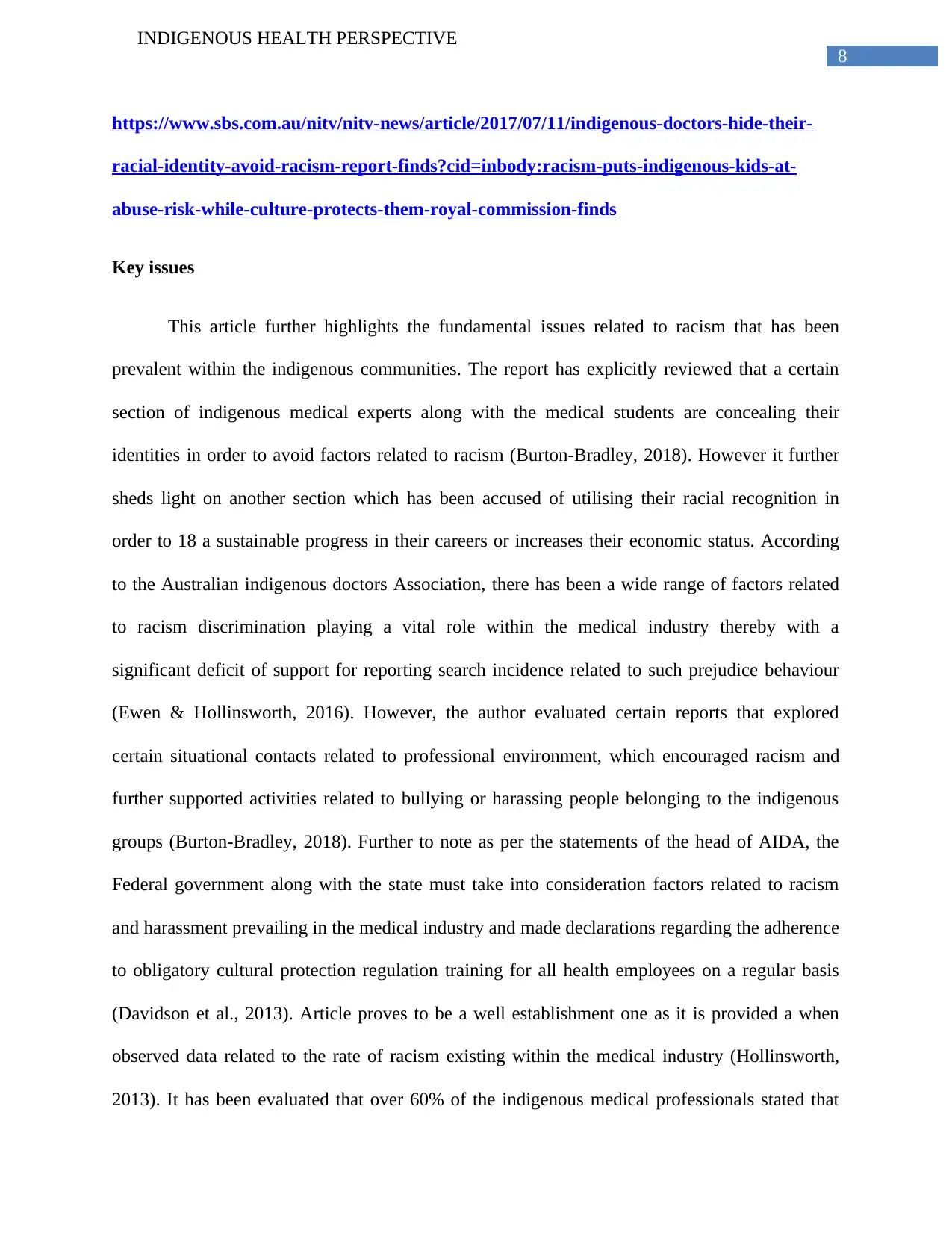
8
INDIGENOUS HEALTH PERSPECTIVE
https://www.sbs.com.au/nitv/nitv-news/article/2017/07/11/indigenous-doctors-hide-their-
racial-identity-avoid-racism-report-finds?cid=inbody:racism-puts-indigenous-kids-at-
abuse-risk-while-culture-protects-them-royal-commission-finds
Key issues
This article further highlights the fundamental issues related to racism that has been
prevalent within the indigenous communities. The report has explicitly reviewed that a certain
section of indigenous medical experts along with the medical students are concealing their
identities in order to avoid factors related to racism (Burton-Bradley, 2018). However it further
sheds light on another section which has been accused of utilising their racial recognition in
order to 18 a sustainable progress in their careers or increases their economic status. According
to the Australian indigenous doctors Association, there has been a wide range of factors related
to racism discrimination playing a vital role within the medical industry thereby with a
significant deficit of support for reporting search incidence related to such prejudice behaviour
(Ewen & Hollinsworth, 2016). However, the author evaluated certain reports that explored
certain situational contacts related to professional environment, which encouraged racism and
further supported activities related to bullying or harassing people belonging to the indigenous
groups (Burton-Bradley, 2018). Further to note as per the statements of the head of AIDA, the
Federal government along with the state must take into consideration factors related to racism
and harassment prevailing in the medical industry and made declarations regarding the adherence
to obligatory cultural protection regulation training for all health employees on a regular basis
(Davidson et al., 2013). Article proves to be a well establishment one as it is provided a when
observed data related to the rate of racism existing within the medical industry (Hollinsworth,
2013). It has been evaluated that over 60% of the indigenous medical professionals stated that
INDIGENOUS HEALTH PERSPECTIVE
https://www.sbs.com.au/nitv/nitv-news/article/2017/07/11/indigenous-doctors-hide-their-
racial-identity-avoid-racism-report-finds?cid=inbody:racism-puts-indigenous-kids-at-
abuse-risk-while-culture-protects-them-royal-commission-finds
Key issues
This article further highlights the fundamental issues related to racism that has been
prevalent within the indigenous communities. The report has explicitly reviewed that a certain
section of indigenous medical experts along with the medical students are concealing their
identities in order to avoid factors related to racism (Burton-Bradley, 2018). However it further
sheds light on another section which has been accused of utilising their racial recognition in
order to 18 a sustainable progress in their careers or increases their economic status. According
to the Australian indigenous doctors Association, there has been a wide range of factors related
to racism discrimination playing a vital role within the medical industry thereby with a
significant deficit of support for reporting search incidence related to such prejudice behaviour
(Ewen & Hollinsworth, 2016). However, the author evaluated certain reports that explored
certain situational contacts related to professional environment, which encouraged racism and
further supported activities related to bullying or harassing people belonging to the indigenous
groups (Burton-Bradley, 2018). Further to note as per the statements of the head of AIDA, the
Federal government along with the state must take into consideration factors related to racism
and harassment prevailing in the medical industry and made declarations regarding the adherence
to obligatory cultural protection regulation training for all health employees on a regular basis
(Davidson et al., 2013). Article proves to be a well establishment one as it is provided a when
observed data related to the rate of racism existing within the medical industry (Hollinsworth,
2013). It has been evaluated that over 60% of the indigenous medical professionals stated that
⊘ This is a preview!⊘
Do you want full access?
Subscribe today to unlock all pages.

Trusted by 1+ million students worldwide
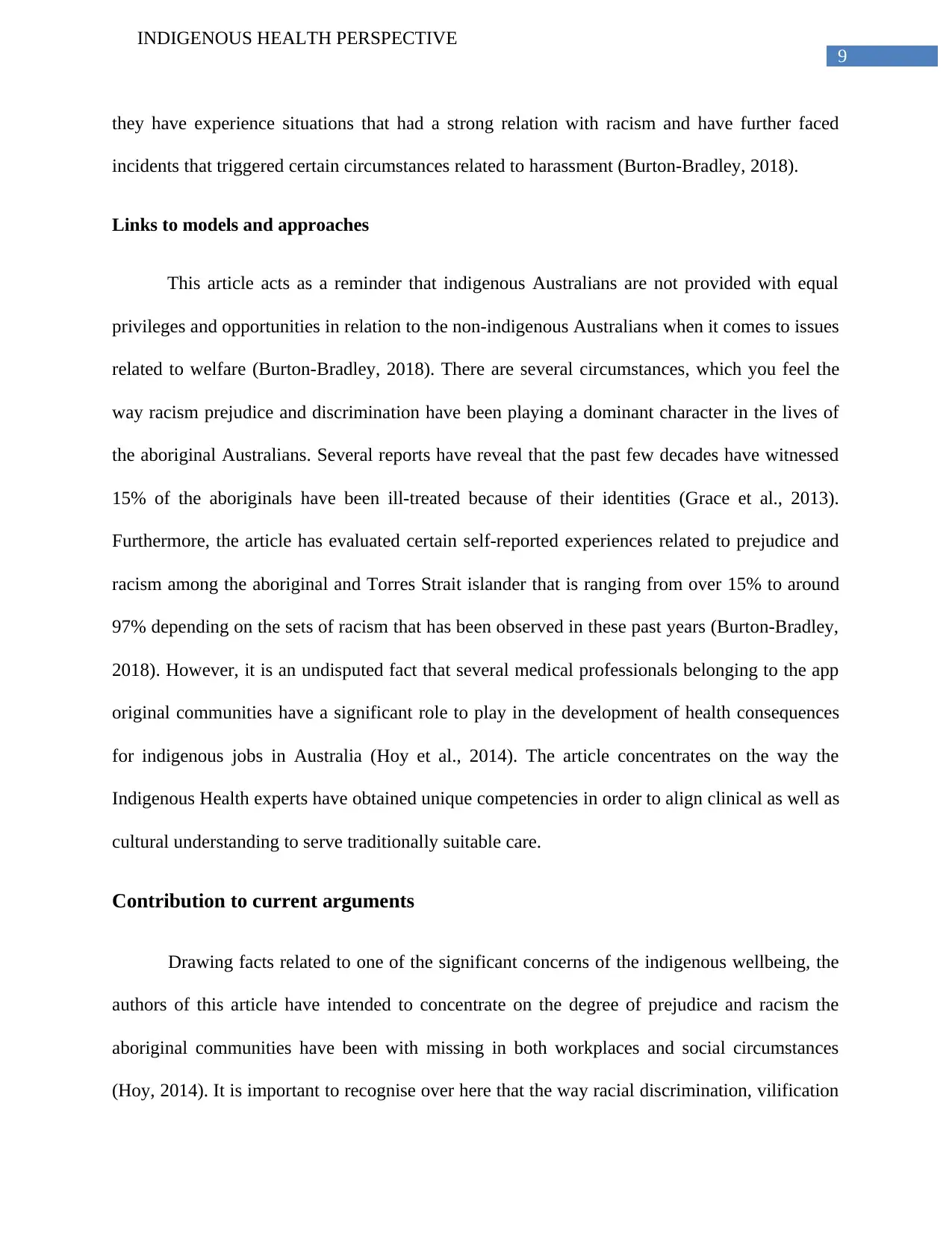
9
INDIGENOUS HEALTH PERSPECTIVE
they have experience situations that had a strong relation with racism and have further faced
incidents that triggered certain circumstances related to harassment (Burton-Bradley, 2018).
Links to models and approaches
This article acts as a reminder that indigenous Australians are not provided with equal
privileges and opportunities in relation to the non-indigenous Australians when it comes to issues
related to welfare (Burton-Bradley, 2018). There are several circumstances, which you feel the
way racism prejudice and discrimination have been playing a dominant character in the lives of
the aboriginal Australians. Several reports have reveal that the past few decades have witnessed
15% of the aboriginals have been ill-treated because of their identities (Grace et al., 2013).
Furthermore, the article has evaluated certain self-reported experiences related to prejudice and
racism among the aboriginal and Torres Strait islander that is ranging from over 15% to around
97% depending on the sets of racism that has been observed in these past years (Burton-Bradley,
2018). However, it is an undisputed fact that several medical professionals belonging to the app
original communities have a significant role to play in the development of health consequences
for indigenous jobs in Australia (Hoy et al., 2014). The article concentrates on the way the
Indigenous Health experts have obtained unique competencies in order to align clinical as well as
cultural understanding to serve traditionally suitable care.
Contribution to current arguments
Drawing facts related to one of the significant concerns of the indigenous wellbeing, the
authors of this article have intended to concentrate on the degree of prejudice and racism the
aboriginal communities have been with missing in both workplaces and social circumstances
(Hoy, 2014). It is important to recognise over here that the way racial discrimination, vilification
INDIGENOUS HEALTH PERSPECTIVE
they have experience situations that had a strong relation with racism and have further faced
incidents that triggered certain circumstances related to harassment (Burton-Bradley, 2018).
Links to models and approaches
This article acts as a reminder that indigenous Australians are not provided with equal
privileges and opportunities in relation to the non-indigenous Australians when it comes to issues
related to welfare (Burton-Bradley, 2018). There are several circumstances, which you feel the
way racism prejudice and discrimination have been playing a dominant character in the lives of
the aboriginal Australians. Several reports have reveal that the past few decades have witnessed
15% of the aboriginals have been ill-treated because of their identities (Grace et al., 2013).
Furthermore, the article has evaluated certain self-reported experiences related to prejudice and
racism among the aboriginal and Torres Strait islander that is ranging from over 15% to around
97% depending on the sets of racism that has been observed in these past years (Burton-Bradley,
2018). However, it is an undisputed fact that several medical professionals belonging to the app
original communities have a significant role to play in the development of health consequences
for indigenous jobs in Australia (Hoy et al., 2014). The article concentrates on the way the
Indigenous Health experts have obtained unique competencies in order to align clinical as well as
cultural understanding to serve traditionally suitable care.
Contribution to current arguments
Drawing facts related to one of the significant concerns of the indigenous wellbeing, the
authors of this article have intended to concentrate on the degree of prejudice and racism the
aboriginal communities have been with missing in both workplaces and social circumstances
(Hoy, 2014). It is important to recognise over here that the way racial discrimination, vilification
Paraphrase This Document
Need a fresh take? Get an instant paraphrase of this document with our AI Paraphraser
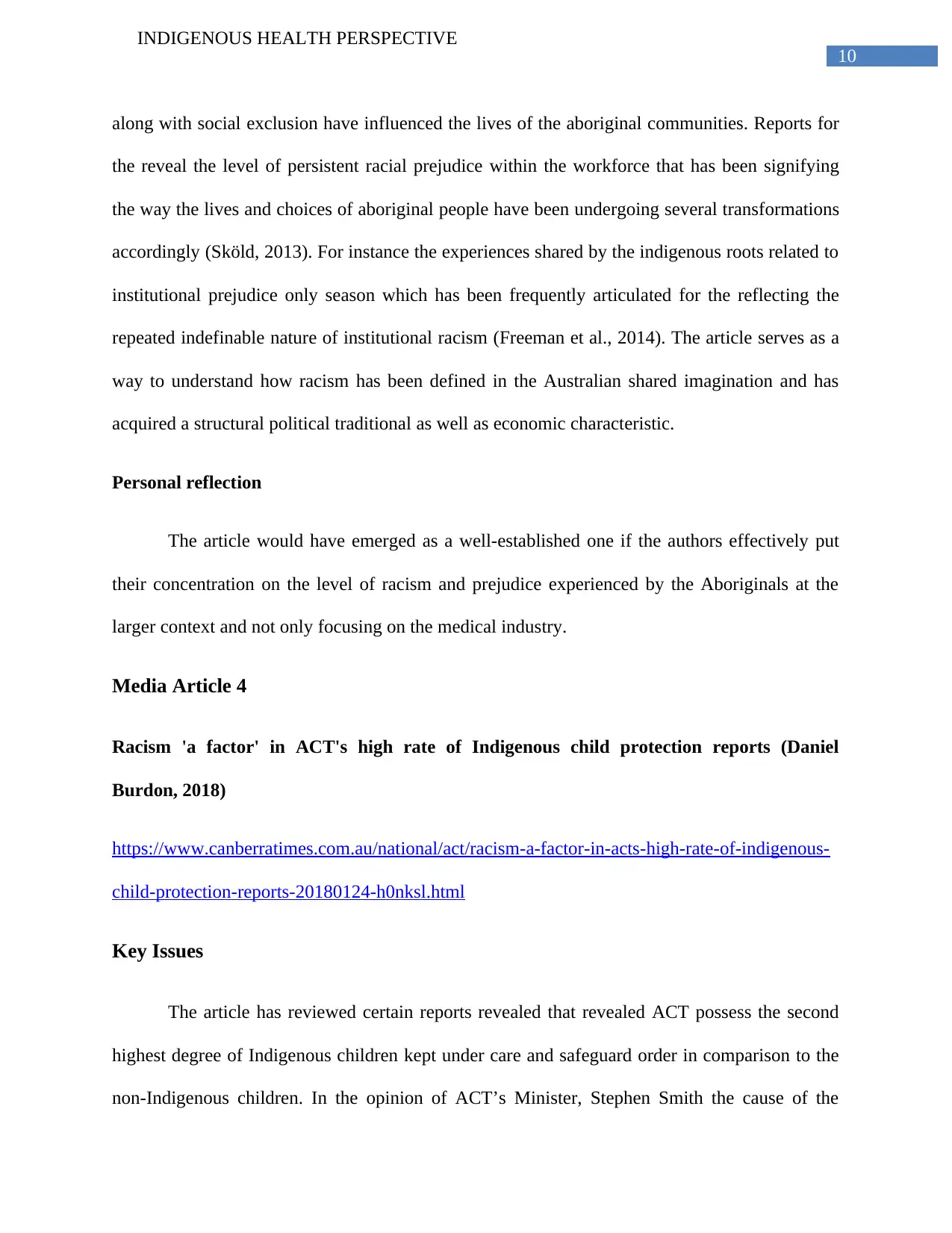
10
INDIGENOUS HEALTH PERSPECTIVE
along with social exclusion have influenced the lives of the aboriginal communities. Reports for
the reveal the level of persistent racial prejudice within the workforce that has been signifying
the way the lives and choices of aboriginal people have been undergoing several transformations
accordingly (Sköld, 2013). For instance the experiences shared by the indigenous roots related to
institutional prejudice only season which has been frequently articulated for the reflecting the
repeated indefinable nature of institutional racism (Freeman et al., 2014). The article serves as a
way to understand how racism has been defined in the Australian shared imagination and has
acquired a structural political traditional as well as economic characteristic.
Personal reflection
The article would have emerged as a well-established one if the authors effectively put
their concentration on the level of racism and prejudice experienced by the Aboriginals at the
larger context and not only focusing on the medical industry.
Media Article 4
Racism 'a factor' in ACT's high rate of Indigenous child protection reports (Daniel
Burdon, 2018)
https://www.canberratimes.com.au/national/act/racism-a-factor-in-acts-high-rate-of-indigenous-
child-protection-reports-20180124-h0nksl.html
Key Issues
The article has reviewed certain reports revealed that revealed ACT possess the second
highest degree of Indigenous children kept under care and safeguard order in comparison to the
non-Indigenous children. In the opinion of ACT’s Minister, Stephen Smith the cause of the
INDIGENOUS HEALTH PERSPECTIVE
along with social exclusion have influenced the lives of the aboriginal communities. Reports for
the reveal the level of persistent racial prejudice within the workforce that has been signifying
the way the lives and choices of aboriginal people have been undergoing several transformations
accordingly (Sköld, 2013). For instance the experiences shared by the indigenous roots related to
institutional prejudice only season which has been frequently articulated for the reflecting the
repeated indefinable nature of institutional racism (Freeman et al., 2014). The article serves as a
way to understand how racism has been defined in the Australian shared imagination and has
acquired a structural political traditional as well as economic characteristic.
Personal reflection
The article would have emerged as a well-established one if the authors effectively put
their concentration on the level of racism and prejudice experienced by the Aboriginals at the
larger context and not only focusing on the medical industry.
Media Article 4
Racism 'a factor' in ACT's high rate of Indigenous child protection reports (Daniel
Burdon, 2018)
https://www.canberratimes.com.au/national/act/racism-a-factor-in-acts-high-rate-of-indigenous-
child-protection-reports-20180124-h0nksl.html
Key Issues
The article has reviewed certain reports revealed that revealed ACT possess the second
highest degree of Indigenous children kept under care and safeguard order in comparison to the
non-Indigenous children. In the opinion of ACT’s Minister, Stephen Smith the cause of the
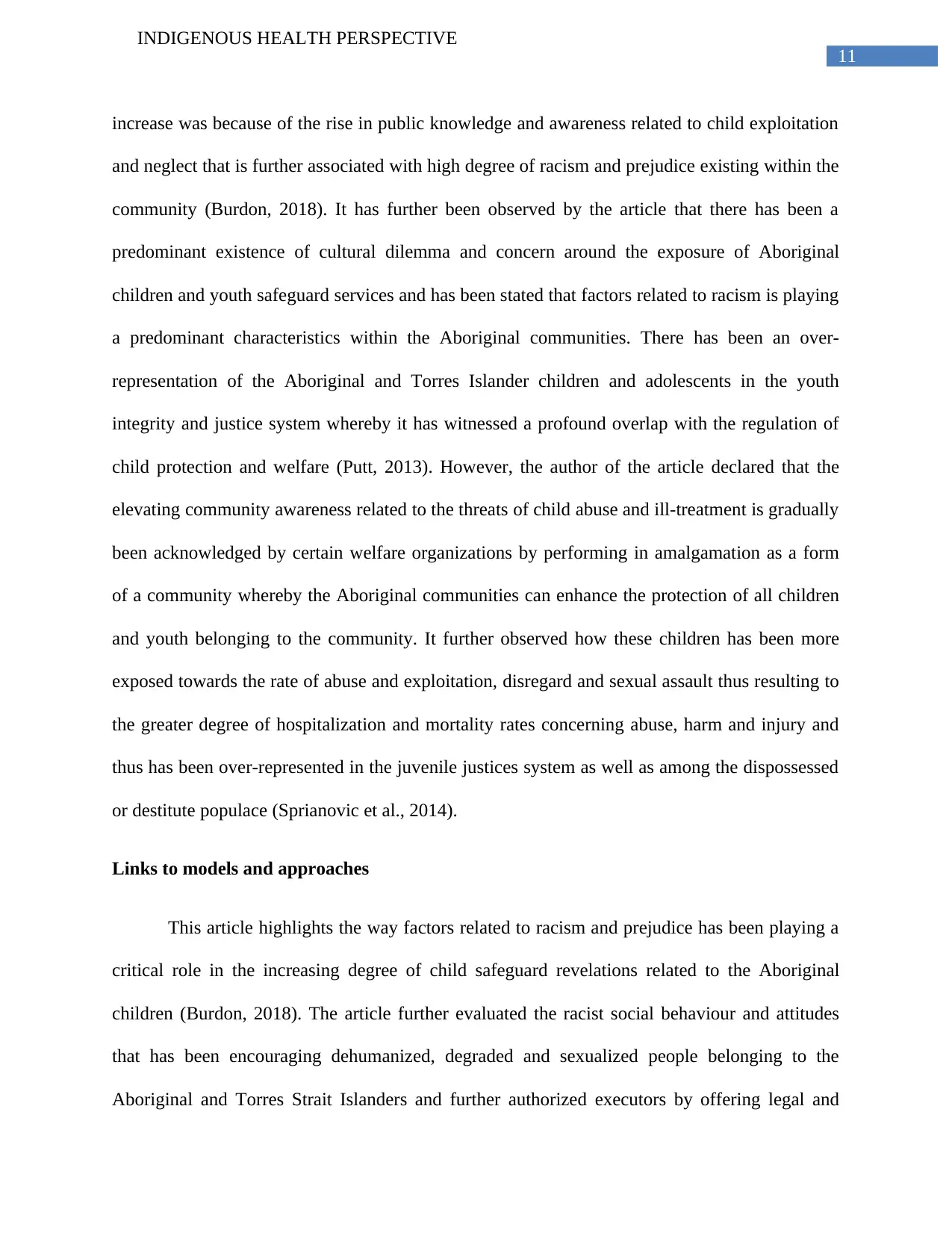
11
INDIGENOUS HEALTH PERSPECTIVE
increase was because of the rise in public knowledge and awareness related to child exploitation
and neglect that is further associated with high degree of racism and prejudice existing within the
community (Burdon, 2018). It has further been observed by the article that there has been a
predominant existence of cultural dilemma and concern around the exposure of Aboriginal
children and youth safeguard services and has been stated that factors related to racism is playing
a predominant characteristics within the Aboriginal communities. There has been an over-
representation of the Aboriginal and Torres Islander children and adolescents in the youth
integrity and justice system whereby it has witnessed a profound overlap with the regulation of
child protection and welfare (Putt, 2013). However, the author of the article declared that the
elevating community awareness related to the threats of child abuse and ill-treatment is gradually
been acknowledged by certain welfare organizations by performing in amalgamation as a form
of a community whereby the Aboriginal communities can enhance the protection of all children
and youth belonging to the community. It further observed how these children has been more
exposed towards the rate of abuse and exploitation, disregard and sexual assault thus resulting to
the greater degree of hospitalization and mortality rates concerning abuse, harm and injury and
thus has been over-represented in the juvenile justices system as well as among the dispossessed
or destitute populace (Sprianovic et al., 2014).
Links to models and approaches
This article highlights the way factors related to racism and prejudice has been playing a
critical role in the increasing degree of child safeguard revelations related to the Aboriginal
children (Burdon, 2018). The article further evaluated the racist social behaviour and attitudes
that has been encouraging dehumanized, degraded and sexualized people belonging to the
Aboriginal and Torres Strait Islanders and further authorized executors by offering legal and
INDIGENOUS HEALTH PERSPECTIVE
increase was because of the rise in public knowledge and awareness related to child exploitation
and neglect that is further associated with high degree of racism and prejudice existing within the
community (Burdon, 2018). It has further been observed by the article that there has been a
predominant existence of cultural dilemma and concern around the exposure of Aboriginal
children and youth safeguard services and has been stated that factors related to racism is playing
a predominant characteristics within the Aboriginal communities. There has been an over-
representation of the Aboriginal and Torres Islander children and adolescents in the youth
integrity and justice system whereby it has witnessed a profound overlap with the regulation of
child protection and welfare (Putt, 2013). However, the author of the article declared that the
elevating community awareness related to the threats of child abuse and ill-treatment is gradually
been acknowledged by certain welfare organizations by performing in amalgamation as a form
of a community whereby the Aboriginal communities can enhance the protection of all children
and youth belonging to the community. It further observed how these children has been more
exposed towards the rate of abuse and exploitation, disregard and sexual assault thus resulting to
the greater degree of hospitalization and mortality rates concerning abuse, harm and injury and
thus has been over-represented in the juvenile justices system as well as among the dispossessed
or destitute populace (Sprianovic et al., 2014).
Links to models and approaches
This article highlights the way factors related to racism and prejudice has been playing a
critical role in the increasing degree of child safeguard revelations related to the Aboriginal
children (Burdon, 2018). The article further evaluated the racist social behaviour and attitudes
that has been encouraging dehumanized, degraded and sexualized people belonging to the
Aboriginal and Torres Strait Islanders and further authorized executors by offering legal and
⊘ This is a preview!⊘
Do you want full access?
Subscribe today to unlock all pages.

Trusted by 1+ million students worldwide
1 out of 19
Related Documents
Your All-in-One AI-Powered Toolkit for Academic Success.
+13062052269
info@desklib.com
Available 24*7 on WhatsApp / Email
![[object Object]](/_next/static/media/star-bottom.7253800d.svg)
Unlock your academic potential
Copyright © 2020–2025 A2Z Services. All Rights Reserved. Developed and managed by ZUCOL.





